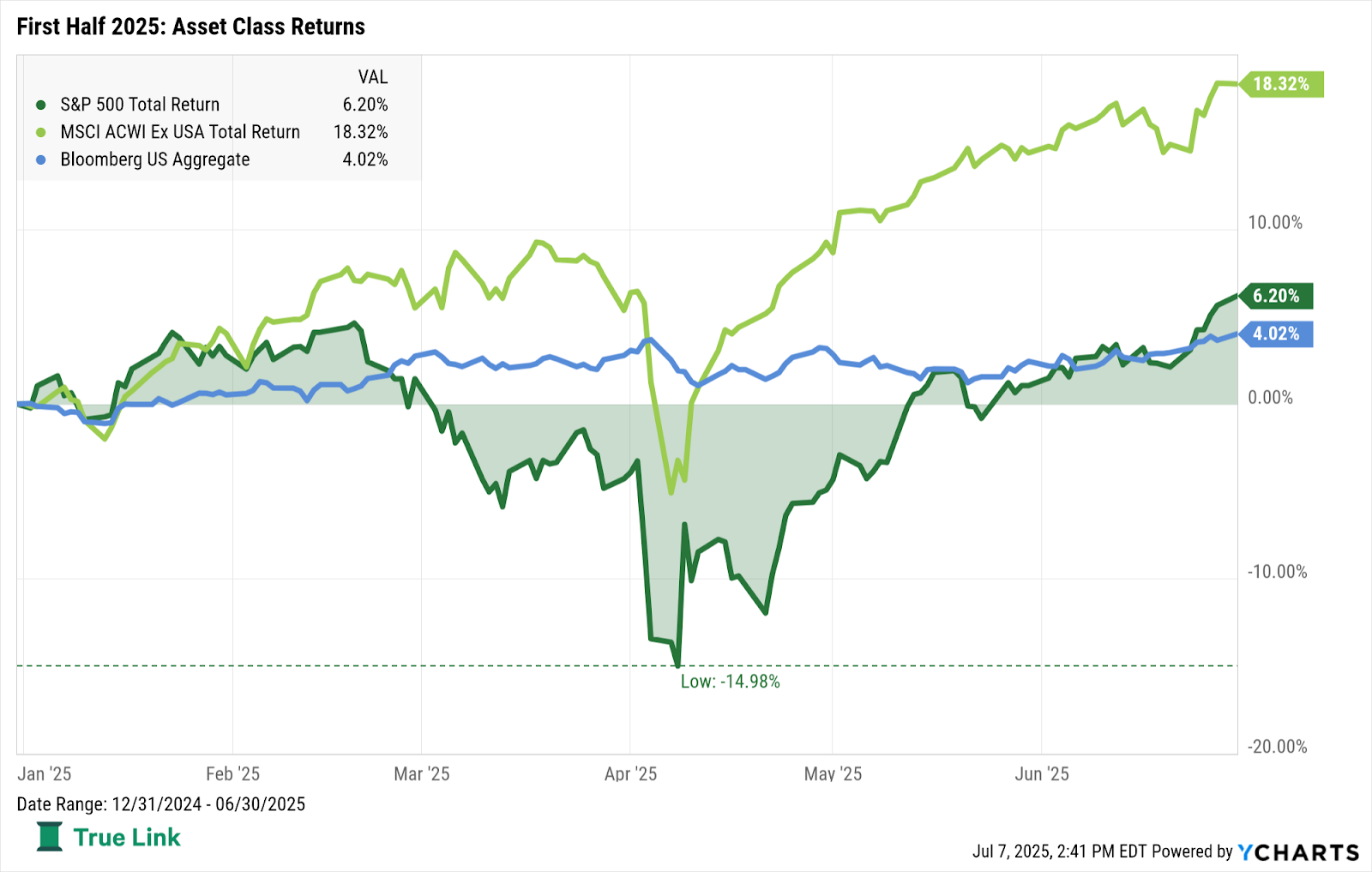Market Update from True Link Financial Advisors, LLC - Q2 2025
Riding a roller coaster elicits a wide range of emotions, from excitement to anxiety. The slow climbs, sudden drops, and unexpected turns can be thrilling for some, while others may find them deeply unsettling. When people describe the recent behavior of financial markets as a “roller coaster,” it’s understandable that even seasoned thrill-seekers might feel uneasy when it comes to investing.
That analogy is particularly relevant in light of the U.S. stock market's performance in the first half of the year, especially during the early part of the second quarter. After a relatively steady ascent heading into 2025, markets were abruptly jolted on April 2 by the announcement of retaliatory tariffs that far exceeded most expectations. The resulting market reaction was swift - the S&P 500 Index, a widely used benchmark for U.S. large-cap stocks, dropped nearly 10% on April 3rd and 4th - the biggest two-day drop since the COVID-19 pandemic. Yet, in true roller coaster fashion, the rebound came nearly as fast. On April 9, news of a temporary 90-day pause on key tariffs sparked one of the strongest single-day gains in U.S. stock market history.
More surprising than the initial drop or rebound was the market’s muted response to what came next. Despite continued uncertainty around trade negotiations, shifting Federal Reserve policy, and significant geopolitical developments—including U.S. intervention in the Israel-Iran conflict—equity markets pushed higher through the end of the quarter. Even oil prices, which have historically spiked during previous periods of Middle East unrest, fell after the surprise U.S. strike on Iran.
In the face of ongoing uncertainty and concerns about the broader economic outlook, the S&P 500 Index finished the second quarter up 10.9%, bringing its year-to-date gain to 6.2%. The recent sharp swings highlight the kind of volatility that can give even experienced long-term investors pause. The stock market often defies short-term logic–It processes news through a forward-looking lens and our emotional responses rarely align with its ultimate path. Similarly, a roller coaster may seem to prepare for one final drop, only to glide smoothly to the end of the ride, leaving some riders wanting more and others simply relieved that it's finished.
These kinds of ups and downs are a normal part of the journey toward long-term investment growth. Investors with longer time horizons or greater risk tolerance—perhaps because they have fewer immediate income needs or possess additional financial resources—may be better positioned to withstand periods of short-term volatility. Conversely, individuals with shorter time horizons or a greater emphasis on capital preservation may naturally prioritize stability over potential gains.

In either case, proper diversification and adherence to a well-aligned investment strategy remain essential. This year has highlighted the value of diversification, both across asset classes and geographies. International stocks, as represented by the MSCI ACWI ex USA Index (which tracks global stocks excluding the U.S.), are up 18.3% year to date, outperforming U.S. stocks.
Investors with more conservative strategies—those holding larger allocations to bonds or cash—experienced lower volatility during the first half of the year. Despite ongoing uncertainty around interest rates, bond markets have held up relatively well. The Bloomberg U.S. Aggregate Bond Index, a broad measure of the U.S. bond market, delivered a 4.0% return in the first half of the year. Notably, bond investments remained positive during the height of stock market volatility, offering a smoother ride for investors with balanced portfolios compared to those heavily concentrated in equities alone.
Just as every roller coaster rider has their unique thrill-seeking preferences, each investor has their perspective on risk and financial goals. A prioritization on the appropriate portfolio diversification and a focus on long-term objectives, can provide a sense of stability and confidence, even during challenging times.
Investing involves risks, including possible loss of principal. The opinions expressed may change as subsequent conditions vary. The information and opinions contained in this material are derived from proprietary and non-proprietary sources deemed to be reliable, are not necessarily all-inclusive and are not guaranteed as to accuracy. Past performance is no guarantee of future results. There is no guarantee that any forecasts made will come to pass.
Investment Advisory Services are provided through True Link Financial Advisors, LLC, (the “Adviser”) an investment adviser registered with the U.S. Securities and Exchange Commission (“SEC”) and wholly-owned subsidiary of True Link Financial, Inc. (“True Link Financial” and, together with the Adviser, “True Link”) Registration with the SEC does not imply a certain level of skill or training nor does it constitute an endorsement of the advisory firm by the SEC. The performance of investments will vary day to day in response to many factors. Asset allocation strategies are subject to the volatility of the financial markets, including without limitation that of the underlying investment options’ asset class. An investment is subject to a high degree of risk, including the risk of loss of an investor’s entire investment, and diversification does not ensure a profit or guarantee against a loss. Nothing contained herein is considered an offer to sell or a solicitation of any offer to buy any securities.





%20(1).png)




